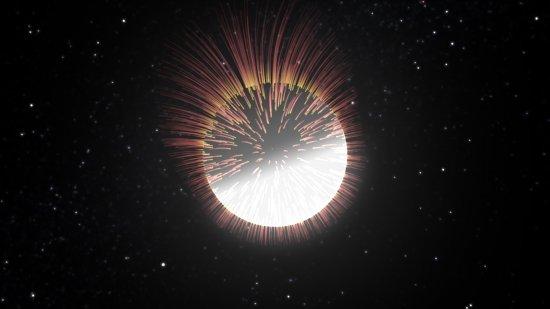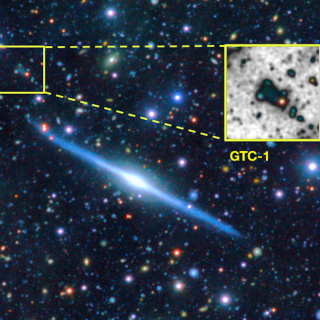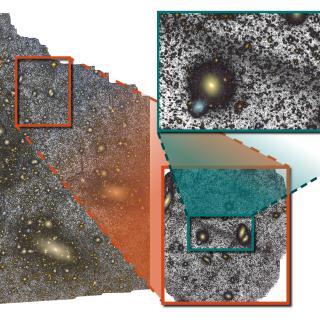Video at the bottom of the page
A white dwarf is a stellar remnant, the final stage for most stars which have exhausted their nuclear fuel. In fact, more than 90% of the stars we know, including the Sun, will go through this phase towards the end of their lives. White dwarfs are very dense stars, which start with very high surface temperatures, and cool down progressively until their temperatures reach those of their surroundings. It is expected that their magnetic fields should decay with time, but observations show that isolated white dwarfs which are already relatively cool, - and which are therefore supposedly the oldest, - often show the strongest magnetic fields, which has intrigued astronomers until now. It is also known that some white dwarfs with very strong magnetic fields vary in brightness as they spin. Among the various mechanisms which have been proposed to explain this is the possible existence of spots, similar to sunspots, on the surface of the white dwarf.
An article which has just come out in the journal Nature among whose authors is Cristina Zurita, a researcher at the Institute of Astrophysics of the Canaries (IAC) and the University of La Laguna (ULL), offers an explanation of this phenomenon: the presence of intense magnetic fields may cause the white dwarf to appear cooler than it is, thus apparently breaking the relationship between temperature and age which has been considered valid until now.
A white dwarf with dark spots
The study is the result of a campaign of almost eight years of observations of the white dwarf WD 1953-011. “The star spins with a period of 1.4 days, so that taking measurements at different times, at different phases of the rotation, we could reconstruct the distribution of the temperature and of the magnetic field across the surface”, explains Cristina Zurita. The results showed that the coolest zones, the darkest, correspond to those where the magnetic field is most intense. This implies that probably within the white dwarf there is a process similar to that which produces sunspots: a very strong magnetic field is blocking the convection, the mechanism which transports heat to the surface, via the internal motion of the fluid phase within the star.
Nevertheless, the spots on WD 1953-011 show different behaviour from sunspots. While the latter are unstable and migrate across the Sun´s surface, on a white dwarf they remain fixed. “Our achievement”, says Cristina Zurita, “has led us to derive two important conclusions. In the first place the majority of white dwarfs with internal convection should show spots, and thus present periodic variations in brightness as they rotate. Secondly, if the magnetic fields are sufficiently strong, the blocking mechanism may work for the whole star, which will make the white dwarf seem cooler”. In that case the relation between temperature and age is not the same as that which had been previously thought, which would explain the long-debated puzzle of why strong magnetic fields are more frequent in cooler white dwarfs.
The observations of this star have been made using spectropolarimetric techniques, with the telescopes VLT, of the European Southern Observatory in Chile, and the BTA, of the Special Astrophysical Observatory in Russia, of 8m and 6m diameter respectively, and also photometric techniques on the telescopes of the San Pedro Mártir Observatory, in Mexico.
Behaviour typical of other white dwarfs
To confirm whether the results obtained in this study of WD 1953-011 can be applied to other white dwarfs, the researchers analyzed several samples of these objects. “Observations show that strong magnetic fields are far more frequent in convective white dwarfs, i.e. in the cooler ones”, notes Zurita. “The mechanism of magnetic blocking of the convection gives a natural explanation for this behaviour.”
In a cool white dwarf almost all the energy is transported to the surface via convection. This means that a white dwarf with a magnetic field sufficiently strong to block the convection should be much less luminous that one with a weak field. As a result, according to the theory of white dwarf cooling the former should evolve much more slowly, in other words its cooling time should be much longer. The effects of the reduction of the cooling rate of the cool magnetic white dwarfs were brought out in a study of the velocities of a white dwarf sample, which gives a measure of their ages. The research team find that the white dwarfs which are coolest and have the strongest magnetic fields are also the oldest group of white dwarfs in the Galaxy. “To summarize, the blocking of the cooling mechanism of white dwarfs by convection affects significantly their cooling sequence, which cannot be considered a good age indicator, unless we take into account the effect of the magnetic field. We think that this study will help in our understanding of the evolution of the Galaxy and of the Universe as a whole”, concludes Zurita.
Scientific paper: “Suppression of cooling by strong magnetic fields in white dwarf stars”. Nature, 19 October 2014. doi: 10.1038/nature13836
Authors: G. Valyavin, D. Shulyak, G. A. Wade, K. Antonyuk, S. V. Zharikov, G. A. Galazutdinov, S. Plachinda, S. Bagnulo, Lester Fox Machado, M. Alvarez, D. M. Clark, J. M. Lopez, D. Hiriart, Inwoo Han, Young-Beom Jeon, C. Zurita, R. Mujica, T. Burlakova, T. Szeifert & A. Burenkov
CONTACT:
Cristina Zurita: 922605382, czurita [at] iac.es (czurita[at]iac[dot]es)
Video / preview:
Description: Simulation of the rotation of the white dwarf WD 1953-011, showing how the cooler, darker zone corresponds to the region in which the very strong magnetic field has blocked the transport of energy by convection. Credits: G. Pérez, IAC (SMM). Valyavin et al., Nature, 19 October 2014.



